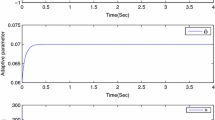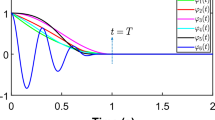Abstract
Time-delayed state feedback is an easy realizable control method that generates control force by differencing the current and the delayed versions of the system states. In this paper, a new form of the time-delayed state feedback structure is introduced. Based on the proposed time-delayed state feedback method, a new robust tracking system is designed. This tracking system improves the conventional state feedback with integral action disturbance rejection characteristics in the presence of the disturbance signals imposed on the system dynamics or on the sensors that measure the system states. Also, the proposed tracking system tracks the ramp-shaped reference input signal, which is not achievable through conventional state feedback. Moreover, since the proposed method adds delays to the closed-loop system dynamics, the ordinary differential equation of the system changes to a delay differential equation with an infinite number of characteristic roots. Thus, conventional pole placement techniques cannot be used to design the time-delayed state feedback controller parameters. In this paper, the simulated annealing algorithm is used to determine the proposed control system parameters and move the unstable roots of the delay differential equation to the left half-plane. Finally, the efficiency of the proposed reference input tracker is demonstrated by presenting two numerical examples.














Similar content being viewed by others
References
MacDonald, N., Cannings, C., Hoppensteadt, Frank C., & Segel, L. A. (1989). Biological delay systems: Linear stability theory (1st ed.). Cambridge: Cambridge University Press.
Chukwu, E. N. (1998). On the controllability of nonlinear economic systems with delay: The Italian example. Applied Mathematics and Computation, 95(2), 245–274.
Zhou, L., & Li, Y. (2009). A dynamic IS-LM business cycle model with two time delays in capital accumulation equation. Journal of Computational and Applied Mathematics, 228(1), 182–187.
Peña, C., & Moreno, E. (2014). Delay at bus stops of transmilenio transport system according to parameters measured “in situ’’. Case study bogotá-Colombia. Procedia-Social and Behavioral Sciences, 160, 121–129.
Allen-Prince, M., Thomas, C., & Yi, S. (2017). Analysis of the effects of communication delays for consensus of networked multi-agent systems. International Journal of Control, Automation and Systems, 15(5), 2320–2328.
Youcef-Toumi, K., & Ito, O. (1988). A time delay controller for systems with unknown dynamics. In Proceedings of the 1988 American control conference (pp. 904–911). Atlanta, GA, USA.
Dadjo Tavakoli, S., Kadkhodaei, G., Hamzeh, M., & Sheshyekani, K. (2017). Non-linear time-delay controller for DC/DC power converters in application of electric vehicles. IET Electrical Systems in Transportation, 7(4), 303–309.
Roy, S., Kar, I. N., Lee, J., & Jin, M. (2017). Adaptive-robust time-delay control for a class of uncertain Euler–Lagrange systems. IEEE Transactions on Industrial Electronics, 64(9), 7109–7119.
Jin, M., Kang, S. H., Chang, P. H., & Lee, J. (2017). Robust control of robot manipulators using inclusive and enhanced time delay control. IEEE/ASME Transactions on Mechatronics, 22(5), 2141–2152.
Liang, C., Zhong, Q., & Xie, J. (2002). Time delay filter technique in TDO feedback control for uncertain flexible systems. In Proceedings of the 4th world congress on intelligent control and automation (pp. 3328–3332). Shanghai, China.
Young-Cheol, L., & Heung-Ho, L. (2005). A position control of a BLDC motor actuator using time delay control and enhanced time delay observer. In Proceedings of the 8th international conference on electrical machines and systems (pp. 1692–1696). Nanjing, China.
Ariba, Y., Gouaisbaut, F., Rahme, S., & Labit, Y. (2012). Traffic monitoring in transmission control protocol/active queue management networks through a time-delay observer. IET Control Theory & Applications, 6(4), 506.
Pyragas, K. (1992). Continuous control of chaos by self-controlling feedback. Physics Letters A, 170, 421–428.
Iu, H. H. C., & Robert, B. (2003). Control of chaos in a PWM current-mode h-bridge inverter using time-delayed feedback. IEEE Transactions on Circuits and Systems I: Fundamental Theory and Applications, 50(8), 1125–1129.
Souza de Paula, A., & Amorim Savi, M. (2009). Controlling chaos in a nonlinear pendulum using an extended time-delayed feedback control method. Chaos, Solitons & Fractals, 42(5), 2981–2988.
Chang-Jin, X., & Yu-Sen, W. (2014). Chaos control of a chemical chaotic system via time-delayed feedback control method. International Journal of Automation and Computing, 11(4), 392–398.
Lei, A. Z., Ji, L., & WeiGuo, X. (2009). Delayed feedback control of a chemical chaotic model. Applied Mathematical Modelling, 33(2), 677–682.
Dhamala, M., Jirsa, V. K., & Ding, M. (2004). Enhancement of neural synchrony by time delay. Physical Review Letters, 92(7), 74104.
Hövel, P. (2010). Control of complex nonlinear systems with delay (1st ed.). Berlin: Springer.
Ilchmann, A., & Sangwin, C. J. (2004). Output feedback stabilisation of minimum phase systems by delays. Systems & Control Letters, 52(3), 233–245.
Sipahi, R., Niculescu, S.-I., Abdallah, C. T., Michiels, W., & Gu, K. (2011). Stability and stabilization of systems with time delay limitations and opportunities. IEEE Control Systems Magazine, 31(1), 38–65.
Huijberts, H., Michiels, W., & Nijmeijer, H. (2009). Stabilizability via time-delayed feedback: An eigenvalue optimization approach. SIAM Journal on Applied Dynamical Systems, 8(1), 1–20.
Dahms, T., Hövel, P., & Schöll, E. (2007). Control of unstable steady states by extended time-delayed feedback. Physical Review E, 76(5), 56201.
Khan, A. A., Tilbury, D. M., & Moyne, J. R. (2008). Favorable effect of time delays on tracking performance of type-i control systems. IET Control Theory & Applications, 2(3), 210–218.
Peilin, F., Niculescu, S., & Jie, C. (2005). Stability of linear neutral time-delay systems: Exact conditions via matrix pencil solutions. IEEE Transactions on Automatic Control, 51(6), 1063–1069.
Sun, J., & Chen, J. (2017). A survey on lyapunov-based methods for stability of linear time-delay systems. Frontiers of Computer Science, 11(4), 555–567.
Keqin, G., Kharitonov, V. L., & Chen, J. (2003). Stability of time-delay systems. Boston: Birkhäuser.
Ramakrishnan, K., & Ray, G. (2009). Delay-dependent stability criteria for linear systems with multiple time-varying delays. In TENCON 2009. 2009 IEEE region 10 conference. Singapore.
Chen, C. T. (1998). Linear system theory and design (3rd ed.). New York: Oxford University Press.
Jeang-Lin, C. (2006). Applying discrete-time proportional integral observers for state and disturbance estimations. IEEE Transactions on Automatic Control, 51(5), 814–818.
Cheng, G., & Peng, K. (2007). Robust composite nonlinear feedback control with application to a servo positioning system. IEEE Transactions on Industrial Electronics, 54(2), 1132–1140.
Pan, Y., Min, W., She, J., Liu, K.-Z., & Nakanishi, Y. (2018). An improved equivalent-input-disturbance approach for repetitive control system with state delay and disturbance. IEEE Transactions on Industrial Electronics, 65(1), 521–531.
Guo, B.-Z., & Jin, F.-F. (2013). The active disturbance rejection and sliding mode control approach to the stabilization of the Euler-Bernoulli beam equation with boundary input disturbance. Automatica, 49(9), 2911–2918.
Ding, Z. (2015). Consensus disturbance rejection with disturbance observers. IEEE Transactions on Industrial Electronics, 62(9), 5829–5837.
Guo, B.-Z., Ze-Hao, W., & Zhou, H.-C. (2015). Active disturbance rejection control approach to output-feedback stabilization of a class of uncertain nonlinear systems subject to stochastic disturbance. IEEE Transactions on Automatic Control, 61(6), 1613–1618.
Ogata, K., & Yang, Y. (2010). Modern control engineering. Upper Saddle River: Prentice hall.
Olgac, N., & Sipahi, R. (2002). An exact method for the stability analysis of time-delayed linear time-invariant (LTI) systems. IEEE Transactions on Automatic Control, 47(5), 793–797.
Michiels, W., & Niculescu, S.-I. (2007). Stability and stabilization of time-delay systems (advances in design & control)(advances in design and control). Philadelphia: SIAM.
Michiels, W., Engelborghs, K., Vansevenant, P., & Roose, D. (2002). Continuous pole placement for delay equations. Automatica, 38(5), 747–761.
Ebenbauer, C., & Allgower, F. (2006). Stability analysis for time-delay systems using Rekasius’s substitution and sum of squares. In Proceedings of the 45th IEEE conference on decision and control (pp. 5376–5381). San Diego, CA, USA.
Michiels, W., & Roose, D. (2002). Limitations of delayed state feedback: a numerical study. International Journal of Bifurcation and Chaos, 12(6), 1309–1320.
Kirkpatrick, S., & Daniel Gelatt, C. (1983). Optimization by simulated annealing. Science, 220(4598), 671–680.
Cerny, V. (1985). Thermodynamical approach to the traveling saleman problem: An efficient simulation algorithm. Journal of Optimization Theory and Applications, 45(1), 41–51.
Alfonzetti, S., Dilettos, E., & Salerno, N. (2006). Simulated annealing with restarts for the optimization of electromagnetic devices. IEEE Transactions on Magnetics, 42(4), 1115–1118.
Haseyama, M., & Matsuura, D. (2006). A filter coefficient quantization method with genetic algorithm, including simulated annealing. IEEE Signal Processing Letters, 13(4), 189–192.
Koen Engelborghs, T., & Luzyanina, & G Samaey. (2000). DDE-BIFTOOL: A Matlab package for bifurcation analysis of delay differential equations. Department of Computer Science, Katholieke Universiteit Leuven. Report TW305.
Geman, S., & Geman, D. (1984). Stochastic relaxation, Gibbs distributions, and the Bayesian restoration of images. IEEE Transactions on Pattern Analysis and Machine Intelligence, PAMI-6(6), 721–741.
Dong-Nan, W., Gao, W.-B., & Chen, M. (1990). Algorithm for simultaneous stabilization of single-input systems via dynamic feedback. International Journal of Control, 51(3), 631–642.
Author information
Authors and Affiliations
Corresponding author
Rights and permissions
About this article
Cite this article
Dastan, Z., Tavakoli-Kakhki, M. Suppression of high order disturbances and tracking for nonchaotic systems: a time-delayed state feedback approach. Control Theory Technol. 20, 54–68 (2022). https://doi.org/10.1007/s11768-021-00073-9
Received:
Revised:
Accepted:
Published:
Issue Date:
DOI: https://doi.org/10.1007/s11768-021-00073-9




